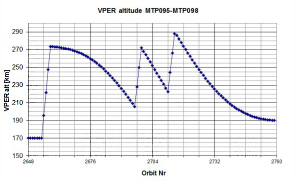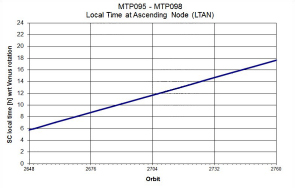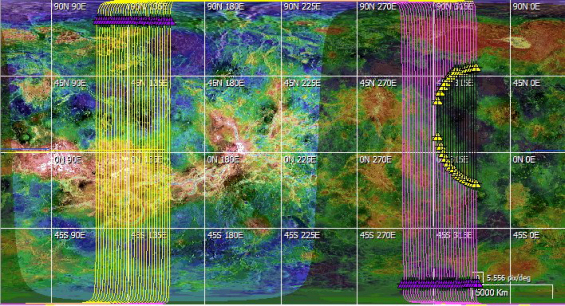No. 264 - Beginning of the twenty-fifth solar eclipse season and continuation of the first sulphur dioxide campaign
Cebreros ground station
All Cebreros ground station activities were nominal during this planning period. Routine maintenance was scheduled on 3 and 4 September, shortening the Earth communication slots on those days.
The ground station experienced a temporary loss of signal on 7 September as a result of which data from the Magnetometer (MAG), the Venus Monitoring Camera (VMC) and the imaging spectrometer (VIRTIS) were lost. The VMC and MAG data were retrieved later, on 10 September. However, the loss of signal occurred towards the end of the pass and due to the volume of VIRTIS data being generated, the lost data were overwritten before they could be retrieved the following day.
High accuracy spacecraft ranging
ESA's Cebreros and New Norcia ground stations were used for a Delta Differential One-way Ranging (delta-DOR, or DDOR) measurement on 21 August and 11 September 2013.
Delta-DOR measurements are carried out with the Venus Express spacecraft on a regular basis to support the accurate determination of the ephemeris for planet Venus that is maintained by NASA's Solar System Dynamics Group.
Data from the New Norcia Delta-DOR pass on 11 September were lost due to problems with the external storage units. The anomaly is under investigation.
Beginning of the twenty-fifth solar eclipse season
The mission's twenty-fifth eclipse season started on 29 August.
Particular science observations are carried out during eclipse seasons: for further details, see the Scientific Focus [hyperlink] section below and 'Science observations with Venus Express during an eclipse'.
Change to battery charge state
The battery's end-of-charge state was set to 100% on 29 August before the start of the twenty-fifth solar eclipse season. This ensures that there is sufficient power in the battery to support emergency operations if the spacecraft goes into a 'safe mode' immediately after one of the regular daily eclipses.
During solar eclipse seasons, the spacecraft is in complete darkness during a portion of each orbit when Venus blocks out the Sun. At this time, the spacecraft bus and payload are powered by the on-board battery, which must then be recharged again to 100% prior to the next eclipse. The battery (composed of three individual battery packs) is sized so that at the end of its life, the spacecraft can go through the longest eclipse and still retain enough stored power for the spacecraft to successfully complete a transition to 'safe mode' in the event of a spacecraft system anomaly.
Outside of the eclipse season, the maximum charge is set at 80%, which is less stressful on the battery, and prolongs its life. The lower end of charge also leaves sufficient reserves of power for the spacecraft to go into safe mode if necessary, and still have enough time to last for the longest possible recovery sequence to a Sun-pointing attitude. Lowering the battery's end-of-charge state prolongs its life.
Spacecraft clock synchronised
The clock on the Venus Express spacecraft is a simple count-up timer, typical of those used on spacecraft. These clocks save weight and cost but they tend to drift, and must be synchronised – or correlated – with atomic clocks on Earth at regular intervals. One of these regular time correlations was performed on 22 August before the Cebreros communication pass. The new time correlation was applied starting from 22 August at 07:00 UTC.
Orbit correction manoeuvres
Three orbit correction manoeuvres were performed to raise the altitude of the pericentre during this reporting period: on 7, 8 and 9 September. At this stage of the mission, with low fuel levels on the spacecraft, the orbit correction manoeuvres are carried out as a number of small burns – rather than fewer large burns – to ensure that they are performed accurately. An explanation for this can be found in Status Report no. 257.
 |
 |
| Change in Venus Express pericentre altitude with time from 21 July to 9 November 2013. Credit: ESA | Venus Express local time at ascending node (LTAN) from 21 July to 9 November 2013. Credit: ESA |
Continuation of the first sulphur dioxide campaign
The first dedicated SO2 observing campaign continued during this reporting period; these observations remained the mission's scientific priority until mid-October 2013.
SO2 is found in small concentrations in other planetary atmospheres. At Venus, however, it is a significant component of the atmospheric chemistry and even forms clouds.
The SO2 observations are performed by SPICAV (Spectroscopy for Investigation of Characteristics of the Atmosphere of Venus), a spectrometer designed to obtain profile measurements (soundings) of the atmosphere during solar and stellar occultations.
During occultation observations, SPICAV points at the planetary limb. For SO2 observations, however, SPICAV is pointed at the nadir, or the sub-satellite point (a point at which a line drawn from the spacecraft to the centre of the planet would intersect with the planet's surface). Pointing at the sub-satellite point instead of the limb allows SPICAV to observe the sunlight reflected off the clouds. The instrument pointings for SO2 observations consist of slews from one side of the sub-satellite point to the other, as the spacecraft moves from south to north over the illuminated day-side of the planet.
SO2 nadir observations were performed throughout this reporting period.
Summary of main activities
The table below shows a chronology of the main spacecraft bus activities in the reporting period:
| Main activities during reporting period | |||
| CEB = Cebreros; DOR = Differential One-way Ranging; DOY = Day of year; MET = Mission elapsed time; NNO = New Norcia; OCM = Orbit Correction Manoeuvre | |||
|
MET (Day) |
Date | DOY | Main Activity |
| 2840 | 18-Aug-2013 | 230 | CEB communications pass. |
| 2841 | 19-Aug-2013 | 231 | CEB communications pass. |
| 2842 | 20-Aug-2013 | 232 | CEB communications pass. |
| 2843 | 21-Aug-2013 | 233 | CEB communications pass; Delta-DOR with CEB and NNO. |
| 2844 | 22-Aug-2013 | 234 | CEB communications pass. Spacecraft clock time correlation performed. |
| 2845 | 23-Aug-2013 | 235 | CEB communications pass. |
| 2846 | 24-Aug-2013 | 236 | CEB communications pass; telemetry switched to 152 kbps. |
| 2847 | 25-Aug-2013 | 237 | CEB communications pass. |
| 2848 | 26-Aug-2013 | 238 | CEB communications pass. |
| 2849 | 27-Aug-2013 | 239 | CEB communications pass. |
| 2850 | 28-Aug-2013 | 240 | CEB communications pass. |
| 2851 | 29-Aug-2013 | 241 | CEB communications pass; start of the twenty-fifth eclipse season and battery charge reconfiguration. |
| 2852 | 30-Aug-2013 | 242 | CEB communications pass. |
| 2853 | 31-Aug-2013 | 243 | CEB communications pass. |
| 2854 | 01-Sep-2013 | 244 | CEB communications pass. |
| 2855 | 02-Sep-2013 | 245 | CEB communications pass. |
| 2856 | 03-Sep-2013 | 246 | CEB communications pass; CEB maintenance. |
| 2857 | 04-Sep-2013 | 247 | CEB communications pass; CEB maintenance. |
| 2858 | 05-Sep-2013 | 248 | CEB communications pass. |
| 2859 | 06-Sep-2013 | 249 | CEB communications pass. |
| 2860 | 07-Sep-2013 | 250 | CEB communications pass; temporary loss of signal; OCM at pericentre. |
| 2861 | 08-Sep-2013 | 251 | CEB communications pass; OCM at pericentre; Telemetry bit rate change from 152 to 182 kbps. |
| 2862 | 09-Sep-2013 | 252 | CEB communications pass; OCM at pericentre. |
| 2863 | 10-Sep-2013 | 253 | CEB communications pass; Retrieval of VMC and MAG data that were lost due to temporary loss of signal on 7 September. VIRTIS data lost permanently. |
| 2864 | 11-Sep-2013 | 254 | CEB communications pass; Delta-DOR passes with CEB and NNO; New Norcia DDOR pass data lost due to problems with the external storage units. |
| 2864 | 12-Sep-2013 | 255 | CEB communications pass. |
| 2866 | 13-Sep-2013 | 256 | CEB communications pass. |
| 2867 | 14-Sep-2013 | 257 | CEB communications pass. |
At the end of the reporting period on 14 September 2013, Venus Express was 154.3 million kilometres from Earth. The one-way signal travel time was 515 seconds. The final oxidizer mass was 16.102 kg and the final fuel mass was 9.810 kg.
Scientific focus
This reporting period falls under the ninety-sixth medium term planning period (MTP), which covered the period from 18 August to 14 September 2013. The twenty-fifth eclipse season started and the first SO2 campaign continued during this reporting period.
Payload activities
| ASPERA | The instrument was regularly operated nominally as part of the routine plan. |
| MAG | The instrument was regularly operated nominally as part of the routine plan. The Cebreros ground station experienced a temporary loss of signal on 7 September as a result of which data from MAG, VMC and VIRTIS were lost. MAG data were retrieved during the next pass, on 10 September. |
| PFS | This instrument was not operated. |
| SPICAV | The instrument was regularly operated nominally as part of the routine plan. |
| VMC |
The instrument was regularly operated nominally as part of the routine plan.
On 20 August, a previously seen VMC error occurred again. Commands sent to the VMC to obtain two images were not executed. This is known to occur occasionally, but the cause has not been determined. However, the camera operated correctly when it was next started. No action is taken for these minor glitches. The Cebreros ground station experienced a temporary loss of signal on 7 September as a result of which data from MAG, VMC and VIRTIS were lost. VMC data were retrieved during the next pass, on 10 September. |
| VeRa | The instrument was regularly operated nominally as part of the routine plan. |
| VIRTIS | The instrument was regularly operated nominally as part of the routine plan. The ground station experienced a temporary loss of signal on 7 September as a result of which data from the Magnetometer (MAG), the Venus Monitoring Camera (VMC) and the imaging spectrometer (VIRTIS) were lost. The VMC and MAG data were retrieved later, on 10 September. However, the loss of signal occurred towards the end of the pass and due to the volume of VIRTIS data being generated, the lost data were overwritten before they could be retrieved the following day. |
Future milestones
- End of the twenty-fifth eclipse season
- Start of inbound quadrature configuration
- High altitude aerobraking flight test
- Start of the thirteenth Atmospheric Drag Experiment Campaign
- Stat of the sixteenth occultation season
Legal disclaimer
This report is based on four ESOC mission operations reports, MOR 403 through MOR 406, as well as the MTP96 Master Science Report. Please see the copyright section of the legal disclaimer (bottom of this page) for terms of use.




